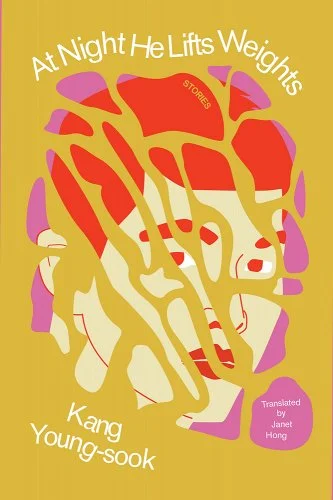[ad_1]
The Translator’s Voice is a new monthly column from Ian J. Battaglia here at the Chicago Review of Books, dedicated to global literature and the translators who work tirelessly and too often thanklessly to bring these books to the English-reading audience. Subscribe to his newsletter to get notified of new editions as well as other notes on writing, art, and more.
The Earth is poisoned. And we’re the ones who did it.
We know this by now. As storms grow more violent each year, our ability to deny the poisoning, which gives life to these increasingly violent storms, slowly diminishes. In the face of this grim future of our own creation, we somehow manage to find reasons to go on; to not just endure, but to live.
These concerns of ours are the same ones facing the characters in Kang Young-sook’s At Night He Lifts Weights, the latest short story collection by the Korean author, translated by Janet Hong. The stories are dark, yes; but Young-sook’s power is her ability to diffuse a sense of life throughout, like a lighthouse cutting through a fog. They stick to you, like the half-remembered dream upon waking.
I spoke with translator Janet Hong about the book, as well as how the structure of Korean lends itself to revelation, finding the themes in a text, and how there’s nothing else for us to do but care, and love.
This conversation has been edited for length and clarity.

Ian J. Battaglia
This book is very dark at times; what’s it like being absorbed in a world like that for so long while you’re working on a translation?
Janet Hong
I naturally gravitate toward works that are quite dark, both to read and translate, so I’m used to managing the emotional aspects of translating pain, trauma, and violence. As many translators say, I believe that the literary translator is the closest reader of a text. For this reason, it seems impossible to translate something well without entering fully into the narrative. One of the ways I cope is to enter gradually. When I produce a first draft, my goal is to simply translate the text. I don’t think about the deeper significance of the words. In a way, I’m translating at the surface level, approaching the text from a distance. It’s with each revision that I allow myself to get closer with the text by using all my senses. My goal is to be so completely in the author’s head at the end that I can fully identify with the characters, feeling what they feel and knowing exactly what they mean. But I do this in bursts—I get in and get out. Once it’s done, I try not to dwell on the dark, heavy sections.
Ian J. Battaglia
Does your process change when you’re translating short stories versus a novel? How do you think about the works separately, or do you treat them the same?
Janet Hong
I typically juggle various projects simultaneously, and this multitasking becomes easier when dealing with short story collections, since I can switch between short stories and other projects more easily. With novels, however, transitioning in and out is a challenge, since I need some time to re-immerse myself in the world of the novel. Given that multitasking isn’t my forte, I try to allocate larger blocks of uninterrupted time to novel translation. This approach allows me to be more consistent, helping me to recall the smaller decisions I’ve made in earlier passages.
The most significant shift in my process comes when working on graphic novels. When I translate prose, I don’t have to worry too much about staying close to the original word count, but in comic translation, the English word count should closely match the original language, since the space where the words fit is so limited. This constraint forces me to be concise and economical with language.
I have to also remember that in comics, images are the real “star” and words are the accompaniment. I try to remember where the words fit in relation to the whole work and sync myself up with what the images are doing.
Ian J. Battaglia
Some of the stories in this collection, like “From Mullae” are almost dream-like (or maybe nightmarish), while others are more realistic or grounded. How much attention do you pay towards making sure a book of short stories feels like a cohesive collection, versus balancing their individuality?
Janet Hong
I don’t consciously focus on creating a cohesive collection when working on the first draft. This concern comes into play later, primarily during the editing process. It’s at this point that I begin to identify underlying connections and recurring themes. I then emphasize these aspects, perhaps by repeating specific words or phrases. It’s worth noting that this narrative throughline is already present in the original work, since it’s something the author was conscious of as she assembled the collection, and further refined by the editors at the Korean publishing house. My role is to simply discern these existing elements, and then polish them, ensuring they shine through clearly in the translation.
Ian J. Battaglia
I felt the prose in “From Mullae” in particular (though this applies to other stories in the collection as well) was very staccato, in a way that felt especially gripping. Was this an intentional choice on your part?
Janet Hong
I wasn’t specifically aiming for a staccato feel in the prose of “From Mullae,” though I’m very conscious of the sentence length, rhythm, tone, and pacing of the source text. Kang’s prose generally features a stark directness, marked by short, terse sentences. My objective isn’t to replicate the sound of the Korean sentences, but to recreate their emotional impact on the reader. For instance, the original sentences in Korean might evoke a sense of unease, dread, or even a sort of matter-of-fact bleakness. Although the English sentences may have a different auditory quality, my aim is to elicit that same sense of tension and apprehension in the reader.
Ian J. Battaglia
Were there any stories in this collection that stood out to you in particular, either because of the process of their translation, or because of the story itself?
Janet Hong
The story “From Mullae” was the first story I had read by Kang and it instantly captivated me, making me want to translate her. It’s a surreal and disorienting piece of eco-fiction that feels eerily prophetic, especially considering it was written almost a decade before the COVID-19 pandemic. The narrative recounts an outbreak of foot-and-mouth disease in a suburban landscape where real estate agents leave bloody footprints on showroom floors, dead birds rain down from the sky, government workers in hazmat suits carry out the wholesale slaughter of infected animals, and the protagonist—an artist—is haunted by her mysterious doppelganger. The terrifying truth is that the story isn’t science fiction, but a reflection of our current world, for many of these incidents are drawn from real life, which intensifies the story’s unsettling impact.
However, amidst the despair, Kang offers a glimmer of hope. In a line reminiscent of the ending of Matthew Arnold’s “Dover Beach,” the narrator of “From Mullae” comes to realize that perhaps now—in this terrifying age of rising sea levels, catastrophic weather events, shortage of food and water supplies, mass extinction, and the emergence of new infectious diseases—now, more than ever, is the time for us to love one another. After all, to love means to be human, to cling to our humanity, ever mindful of our relationship to people and nature. And this love may be the very thing we desperately need.
Ian J. Battaglia
“Processions” feels a bit different from most of the other stories in the collection, as especially juxtaposed to the others, it felt almost optimistic to me. Did it feel this way to you, too? Did you play any role in the order of the stories?
Janet Hong
We retained the same story order as the original, but I did make some adjustments. For instance, I changed the title to better reflect the collection’s overall theme, and to add a sense of closure.
I can see why you might find “Processions” more optimistic compared to the other stories. It does center around the meeting of two disillusioned people, hinting at a new beginning. That said, perhaps with the exception of “City of Anxiety,” I’d argue that every story in the collection carries a glimmer of hope, no matter how grim or bleak they might seem. This, I believe, is the unique power of Kang Young-sook. While she paints a rather bleak and unsettling world, the characters inhabiting it often possess an odd blend of humor and vitality that feels strangely uplifting, in a way that seems at odds with their surroundings.
Ian J. Battaglia
Many of the stories in this collection deal with issues that loom large in Korean culture—such as gender roles, feelings of depression or inadequacy, and personal debt—though of course these extend beyond the borders of Korea. What’s it like to bring these issues and ideas to a wider stage?
Janet Hong
In At Night He Lifts Weights, Kang Young-sook has captured a sense of social and individual unease, touching on a wide range of topics from labor unrest and government corruption to protests and demonstrations. These issues form the backdrop of the collection and reflect the lived experiences of Koreans, especially those navigating the complexities of the 2000s and 2010s. For readers familiar with Korean history, they evoke painful periods such as the 1997 Asian Financial Crisis or the suicide of former Korean president Roh Moo-hyun in 2009.
Yet, what makes Kang’s work universally appealing is her ability to transcend national issues. While rooted in the Korean context, she also alludes to global disasters like Hurricane Katrina, the Chernobyl nuclear catastrophe, the Iowa flood of 2008, and even disease outbreaks like foot-and-mouth and avian flu. As you noted, these issues aren’t confined to Korea; they extend beyond its borders.
Kang demonstrates that these human struggles resonate across borders. And isn’t that the essence of translation? At its heart, translation is an empathetic act, one that allows us to enter another’s experience through language, thereby breaking down the very notion of “otherness.” As a translator, I’m deeply committed to facilitating this exchange and fostering greater empathy among people from diverse backgrounds.
Ian J. Battaglia
Of course, the environment looms large in almost all of these stories. In some of the stories, the Earth itself feels poisoned, which in-turn affects the characters. I was thinking of this a lot while reading—the wildfire smoke made the Chicago air dangerous for a few days, and just this week we had a heatwave that reached an excess of 112°F. Have you written or translated climate fiction before? How important are these issues to you?
Janet Hong
Many works I’ve translated touch on similar themes, but Kang’s focus on environmental decay is particularly resonant. Much of her work falls under the category of climate or ecofiction, featuring themes of sickness, disaster, decay, stench, and even fine dust. The haunting image of a polluted, deteriorating Earth is a recurring element in her stories, and it’s clear that we, as humans, bear the responsibility for this crisis. It’s as though she’s pointing to a sick Earth as a mirror for a sick humanity.
Once you become aware of the environmental crisis, it’s hard to look the other way. Small but insidious signs, like the excessive packaging that comes with many products we buy, serve as everyday reminders that we are contributing to the problem. Then there are more glaring indicators of the crisis, making indifference impossible. For instance, when poor air quality forces us to keep windows shut, when people succumb to heatwaves, or when sea animals die en masse, leaving a stench in the air, the urgency of these issues becomes increasingly difficult to ignore.
The growing environmental crisis isn’t just a “matter of importance.” It’s clear we haven’t been good stewards of our planet, and the mess we’re in is of our own making. It’s not about whether we should care about these issues. If you live on this planet, you must care. We have no choice but to care and do our part.
Ian J. Battaglia
As someone not too familiar with the Korean language, could you talk a bit about the process of translating Korean to English? What are some things you have to look out for?
Janet Hong
Translating from Korean to English presents unique challenges, often stemming from fundamental differences between the two languages. One of the most notable disparities lies in the default sentence structures. Korean usually follows a Subject-Object-Verb (SOV) pattern, while English typically uses a Subject-Verb-Object (SVO) order. Korean writers often exploit this to great effect, creating a sense of delayed payoff at the end of their sentences. Replicating this effect in English can be difficult, as the natural structure of an English sentence tends to resist such a setup.
The challenge, then, is to find creative ways to present information in English that achieve a similar impact. If you reveal the punchline too early in a sentence, the tension that keeps readers engaged slackens, and the narrative can fall flat. This is true not just for the overall pacing of a story, but also at the sentence level. Finding a way to balance this when the inherent sentence structures of Korean and English are so different is a challenge I find myself pondering these days.
Another aspect worth mentioning is the stylistic differences between the two languages. While Korean prose is more accepting of ambiguity and repetition, English tends to prioritize precision and succinctness. These cultural differences in what is considered “good writing” have to be carefully navigated during the translation process.
So, in essence, the task often involves more than just translating words. It’s about translating the pacing, tone, tension, cultural nuances—things you don’t see on the page.
Ian J. Battaglia
What stood out to you about the work of Kang Young-sook?
Janet Hong
A pervasive sense of dystopia runs through all of Kang Young-sook’s stories. She’s got a knack for blending the grotesque, surreal, and sensual, in a way that’s unsettling yet captivating. What’s most striking, though, is how her characters are far from defeated in these bleak worlds. Even as they’re struggling, they’re teeming with life, finding love and humor amid the chaos.
It’s this paradox that’s so fascinating about Kang’s work. She confronts us with grim realities—our polluted, doomed world and our inevitable march toward death—yet she tackles these themes with vigor and even a dash of humor. Her characters are like bright sparks in a dark night, striving to make the most of their circumstances. It’s as though Kang is asking, “Yes, the world is doomed, but what should we do in the meantime?”
This theme finds echoes in the film Don’t Look Up. (Spoiler alert for those who haven’t seen it.) The movie centers around two astronomers who attempt to warn humanity about an approaching comet that threatens to destroy civilization. When their warnings are ignored, they—and by extension, we—are left to grapple with how to spend the time we have left. In the final scene as the comet approaches, the main characters spend their last moments having an ordinary dinner together. While Kang Young-sook’s stories often paint a bleak picture, they also inspire a unique form of optimism—one that finds hope in human connection, even in the face of doom. According to Kang, when the world is going to ruin, all you can do is live—truly live, finding joy, love, and connection, even when everything seems pointless.
Ian J. Battaglia
What was the most difficult part about translating this book?
Janet Hong
Translating “Disaster Area Tour Bus” was particularly challenging. Although it’s not explicitly stated, it’s clear that the story unfolds in New Orleans in the aftermath of Hurricane Katrina. The bus driver serves as the emotional core of the story, delivering an elegiac monologue that offers a firsthand account of the city and its people during and after the hurricane.
In the Korean text, Kang writes that the bus driver speaks in a thick dialect. My initial translation was straightforward, merely indicating that the driver speaks in a dialect, but it didn’t actually show him speaking it with all the dialect’s unique features. This felt unsatisfying, almost like a cop-out, particularly because the story is set in the United States and the character is speaking English.
To address this, I revised the translation to incorporate the New Orleans dialect, even using phonetic spelling to capture the accent. However, since I’m not from the area, I felt I had to proceed cautiously to avoid caricaturing the character. After consulting a trusted translator colleague, I toned down the dialect and focused on capturing its essence through diction and syntax, while using standard spelling. I hope this approach does justice to both the character and the emotional depth of the story.

FICTION
At Night He Lifts Weights
By Kang Young-sook
Translated by Janet Hong
Transit Books
Published November 13, 2023

[ad_2]
Source link

